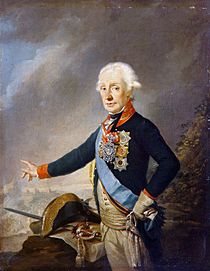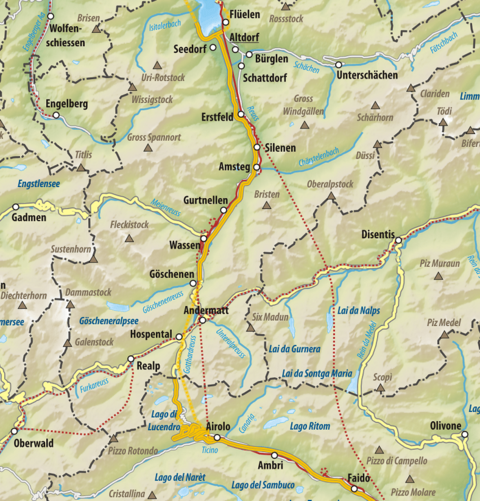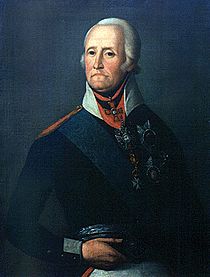Battle of Gotthard Pass facts for kids
Quick facts for kids Battles at the Saint-Gotthard |
|||||||
|---|---|---|---|---|---|---|---|
| Part of Suvorov's Swiss campaign in the war of the Second Coalition | |||||||
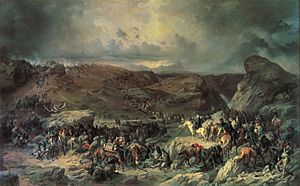 Suvorov's army crosses St. Gotthard Pass in 1799 by Alexander Kotzebue |
|||||||
|
|||||||
| Belligerents | |||||||
| Commanders and leaders | |||||||
| Strength | |||||||
| 6,700 involved in the St. Gotthard Pass and at the Devil's Bridge [ru] |
10,100–11,599 including 2,599 unengaged troops 6,000 involved in the St. Gotthard Pass and at the Devil's Bridge |
||||||
| Casualties and losses | |||||||
| 2,000–6,000 including the St. Gotthard Pass, Oberalpsee, Hospital, Urseren valley, Devil's Bridge | 2,000 including the St. Gotthard Pass, Oberalpsee, Hospital, Urseren valley, Devil's Bridge 10 guns |
||||||
The Battles at the Gotthard Pass were a series of important fights that happened in the Swiss Alps in September 1799. These battles were part of a bigger conflict called the War of the Second Coalition, which involved many European countries.
During these battles, a Russian army led by the famous General Alexander Suvorov teamed up with some Austrian soldiers. They attacked a French army division commanded by General Claude Lecourbe. The fighting took place over several days, from September 23 to 27, 1799.
The main goal for Suvorov's army was to capture the Gotthard Pass, a key mountain route. They succeeded after tough fighting. Then, they pushed north through the mountains, even crossing the famous Teufelsbrücke (Devil's Bridge).
However, this offensive was part of a larger plan that went wrong. The Allies (Russia and Austria) wanted to join their armies in Switzerland to defeat the French. But at the same time, the French army, led by General André Masséna, surprised and defeated other Allied forces in different battles. This left Suvorov's army deep in enemy territory, surrounded by French troops.
Contents
Why Did the Battles Happen?
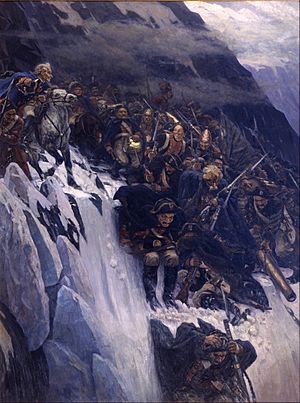
The Big Plan That Went Wrong
In the middle of 1799, the Allied countries (like Britain, Russia, and Austria) came up with a huge plan. They wanted to combine their armies in Switzerland. The idea was for a Russian army of 45,000 soldiers, led by General Alexander Korsakov, to meet up with Suvorov's 20,000 Russian soldiers. Suvorov's troops would march north from Italy to join them.
Once together, Suvorov would lead this large army to push the French out of Switzerland. After that, they planned to invade France itself. Other parts of the plan involved Austrian armies moving into Germany and France, and a British-Russian army landing in the Netherlands.
Problems with the Plan
This big plan had many problems. First, the numbers were wrong. General Korsakov had fewer soldiers than expected. Second, the timing was terrible. The Austrian army, led by Archduke Charles, Duke of Teschen, left Switzerland too early. Suvorov's army, on the other hand, arrived too late.
This meant that Korsakov and another Austrian general, Friedrich Freiherr von Hotze, were left alone to face the strong French army. The French general, Masséna, was ready for them. This bad timing made the Allied forces very vulnerable.
Suvorov's Difficult March
Suvorov's army was supposed to get supplies from the Austrians for their march. They needed mules to carry food and equipment through the mountains. However, there weren't enough mules or money to pay the mule drivers. Many drivers left with their animals.
To solve this, Suvorov made a tough decision. He ordered 1,500 of his Cossacks to give up their horses to be used as pack animals. This was hard because the Cossacks owned their horses.
Suvorov chose the Gotthard Pass route because it was the most direct way to meet the other Allied armies. However, this pass was known to be held by the French. It was a very difficult path, only suitable for mules, not wagons or heavy cannons.
His army was divided into two main groups. One group, led by General Wilhelm Derfelden, would make the main attack on the Gotthard Pass. The other group, led by General Andrei Rosenberg, would take a different route over the Lukmanier Pass to attack from another direction. The Russian cannons had to take a much longer route because they couldn't cross the Gotthard Pass.
The soldiers marched in heavy rain, and some men and horses died in falls while crossing the passes. By September 23, Suvorov's main force reached Faido, ready to attack the Gotthard Pass.
The Battles: September 24-26
September 24: Fighting for the Gotthard Pass
The French general, Lecourbe, had his soldiers spread out to defend the mountain passes. He had about 3,800 men defending the Gotthard Pass and other nearby areas. Lecourbe didn't believe the rumors that Suvorov's large army was coming. He thought it was just a small scouting group. This meant he wasn't fully ready for the big attack.
Suvorov's plan for September 24 was to attack the Gotthard Pass head-on with his main force. At the same time, General Rosenberg's troops would attack from the side, aiming to capture Andermatt to the north. Another Austrian group, led by General Franz Xaver von Auffenberg, would go even wider to block the main valley at Amsteg.
The attack on the Gotthard Pass started later than planned, around 2:00 pm. The French quickly left Airolo and set up defenses on the slopes above. The attacking soldiers had to climb about 900 meters (3,000 feet) while being shot at.
The fighting was very tough. The Russian soldiers faced strong French resistance. At one point, Suvorov's troops struggled, and he famously lay down in a ditch, saying he would rather die than see his soldiers fail. This dramatic act inspired his soldiers, and they rallied to continue the attack.
Finally, the Allies fought their way to the top of the pass. Just then, another Russian group appeared, having climbed the steep slopes from the east. Fearing they would be surrounded, the French quickly left their positions and retreated north. This fierce battle cost the Allies about 1,200 soldiers.
Meanwhile, Rosenberg's and Auffenberg's groups were also fighting. Rosenberg's troops fought their way to Andermatt by evening, pushing back the French. The French defenders then retreated to Hospental. That night, Russian soldiers occupied Hospental. The French general, Gudin, had to abandon his cannons and retreat southwest towards the Furka Pass to avoid being trapped.
September 25: The Battle of the Devil's Bridge
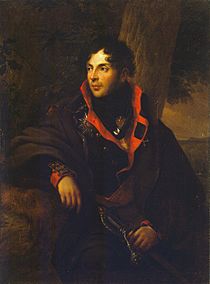
Suvorov's troops left Hospental early on September 25, heading north. They soon reached the Schöllenen Gorge, a very narrow canyon. This gorge had a tunnel called the Urnerloch and the famous Teufelsbrücke (Devil's Bridge). The French had strong defenses here.
To capture the Devil's Bridge, Russian soldiers had to climb the steep sides of the gorge. One group climbed the west side, another climbed a mountain on the right, and a third group went directly through the tunnel. The French fired cannons at the Russians as they came out of the tunnel.
At the same time, General Auffenberg's Austrian troops were making their way towards Amsteg, threatening the French from behind. When Lecourbe heard about this threat, he took 1,600 soldiers to deal with the Austrians. This weakened the French defenses at the Devil's Bridge.
With fewer defenders, the French at the Devil's Bridge were pushed back. They threw their cannon into the gorge and destroyed part of the road to slow down the Russians. The Russians kept pushing, and some French soldiers were forced to retreat into the mountains. The Russian pursuit stopped at nightfall. Lecourbe then burned the bridge at Amsteg and retreated further north.
This day, September 25, was a disaster for the overall Allied plan. While Suvorov was fighting in the mountains, Masséna attacked Korsakov's Russian army in the Second Battle of Zurich and defeated them. Another Austrian force was also beaten. This meant Suvorov's army was now alone and surrounded by victorious French forces.
September 26: Reaching Altdorf
On September 26, Suvorov's leading troops joined Auffenberg's Austrians. They continued to push the French back. There was a small fight near Altdorf before the French retreated to Seedorf. Lecourbe tried to keep the Allies on the east side of the Reuss River and burned bridges to slow them down.
Rosenberg and Auffenberg entered Altdorf around noon. Suvorov himself arrived in Altdorf that evening. His army had marched about 80 miles (130 km) in five days through extremely difficult mountain terrain. This was a great achievement.
However, the Russian army was running out of supplies. They had eaten all the food found in Andermatt and Altdorf. Soldiers were so hungry they tried to chew on old animal skins. Suvorov decided to turn east from Altdorf and cross another mountain pass, the Kinzig Pass, hoping to find supplies at Schwyz.
Meanwhile, the other Allied forces Suvorov was supposed to meet were also in trouble. One Austrian column was defeated and retreated. Another Austrian column managed to capture a town, but then had to deal with French counterattacks. The Allies Suvorov was counting on were being defeated one by one. Masséna, the French commander, knew Suvorov was coming and ordered more French troops to block his path.
What Happened Next?
From September 24 to 27, both the French and Allied armies lost about 2,000 soldiers each. The French also lost 10 cannons, which they threw into the Reuss River so the Allies couldn't capture them.
On September 27, Suvorov's army began crossing the Kinzig Pass. This was another tough mountain crossing. General Rosenberg's group stayed behind to protect the supplies and act as a rearguard. The French attacked Altdorf again, but Rosenberg's troops pushed them back.
On September 28, Rosenberg's corps also started crossing the Kinzig Pass in rain and snow. That same day, Russian scouts discovered that Masséna had won a huge victory at Zurich. This meant Suvorov's army was now trapped in Switzerland, surrounded by a victorious French army.
Forces Involved
Austro-Russian Army
French Army
| Divisions | Brigades | Units | Strength | Location |
|---|---|---|---|---|
| Division Lecourbe General of Division Claude Lecourbe |
General of Brigade Charles-Étienne Gudin |
1,861 | Gotthard Pass | |
| 1,700 | Oberalp Pass | |||
| 240 | Andermatt | |||
| General of Brigade Louis Henri Loison |
2,180 | Amsteg | ||
| 800 | Amsteg | |||
| Divisional Reserve | 720 | Altdorf | ||
| ? | Schwyz | |||
| General of Brigade Gabriel Jean Joseph Molitor |
2,599 | Glarus Detached - Not engaged |
Images for kids
See also


